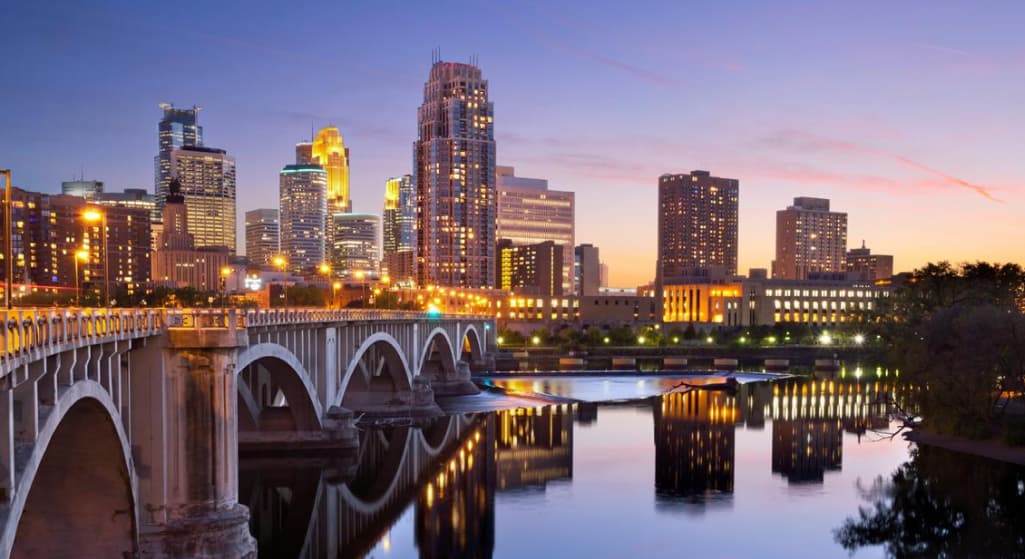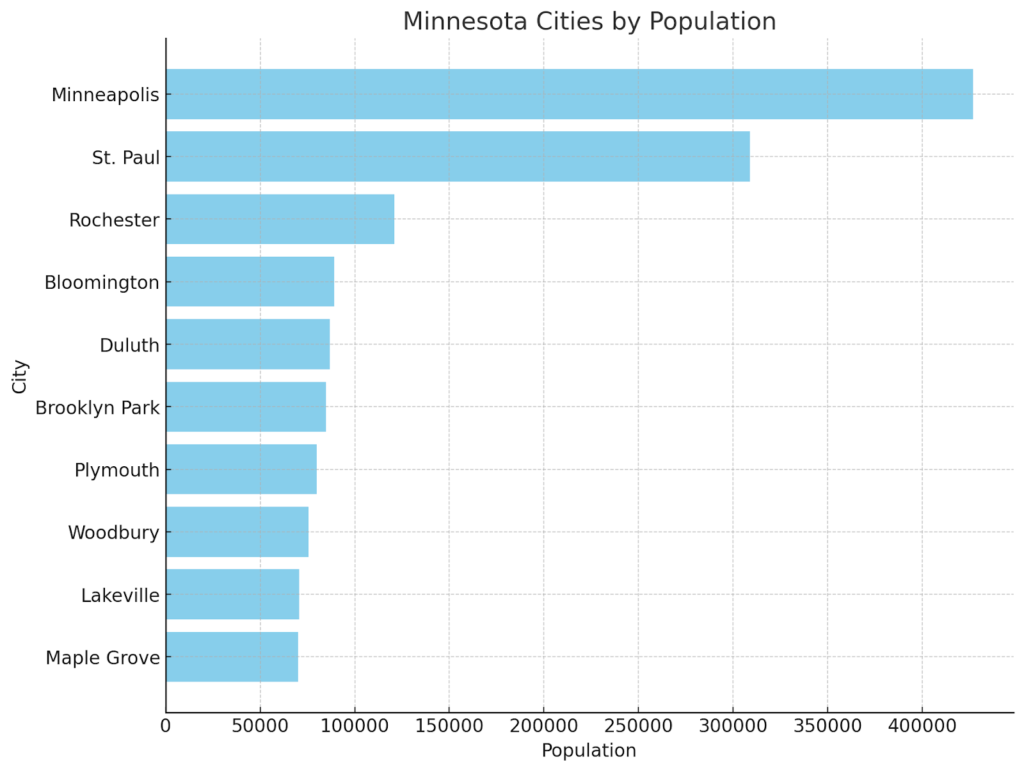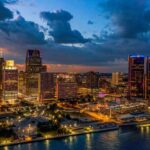
Minnesota, known as the “Land of 10,000 Lakes,” is a state rich in natural beauty, cultural heritage, and economic vitality. It boasts a diverse landscape that ranges from the bustling Twin Cities to serene wilderness areas, making it a unique blend of urban and rural. The state’s cities are central to its identity, each contributing distinct characteristics that enrich Minnesota as a whole. This article ranks the top 10 most populous cities in Minnesota, offering a detailed look into what makes each city a vital part of the state’s fabric.
From the vibrant arts scene and economic hub of Minneapolis to the historic and laid-back atmosphere of St. Paul; from Rochester’s cutting-edge healthcare innovation to Bloomington’s retail paradise; and from Duluth’s scenic beauty to Brooklyn Park’s community engagement—each city has its own story. Plymouth’s commitment to community well-being, Woodbury’s high living standards, Lakeville’s charming lakeside lifestyle, and Maple Grove’s dynamic growth reflect the diverse and dynamic nature of Minnesota. Together, these cities showcase the rich tapestry of life in the North Star State, making it a wonderful place to live, work, and explore. The graph above visually represents the population distribution across these cities, highlighting the scale and scope of urban life in Minnesota.
What are the Top Minnesota Cities by Population?

1. Minneapolis – Population: 426,877
Minneapolis, the largest city in Minnesota, is the heart of the Twin Cities metropolitan area. Known for its vibrant arts scene, extensive park systems, and economic importance, Minneapolis is a hub of cultural and recreational activities. The city boasts numerous theaters, museums, and galleries, including the Walker Art Center and the Minneapolis Institute of Art. The Mississippi River adds to the city’s charm, providing scenic beauty and recreational opportunities. Minneapolis also serves as a business center, home to several Fortune 500 companies. The city’s diversity is celebrated through its various cultural festivals and neighborhoods, making it a melting pot of traditions and communities.
2. St. Paul – Population: 308,806
St. Paul, the state capital, complements Minneapolis to form the Twin Cities. With its rich history and architectural treasures, St. Paul offers a more laid-back vibe compared to its twin. The city is known for its well-preserved Victorian-era homes, the majestic Cathedral of Saint Paul, and the state capitol building. The Minnesota History Center and the Science Museum of Minnesota are key attractions, offering insights into the state’s past and scientific wonders. St. Paul also boasts a vibrant arts scene, with the Ordway Center for the Performing Arts hosting a variety of performances. The city’s diverse neighborhoods, like the historic Lowertown and the bustling Grand Avenue, provide a plethora of dining and shopping options.
3. Rochester – Population: 120,848
Rochester is renowned globally as the home of the Mayo Clinic, a world-leading medical facility and research center. This city offers a unique blend of small-town charm and cutting-edge healthcare innovation. Rochester’s strong sense of community and high quality of life are complemented by its cultural institutions, such as the Rochester Art Center and the Mayo Civic Center. The city’s extensive parks and trails system encourages outdoor activities, while its downtown area is undergoing significant redevelopment to enhance its appeal as a destination for both residents and visitors. Rochester’s emphasis on healthcare and education has attracted a diverse, highly educated population.
The presence of the Mayo Clinic not only defines Rochester’s identity as a city but also drives its economy, drawing patients and medical professionals from around the world. This influx contributes to the city’s cosmopolitan atmosphere, with a variety of dining, shopping, and cultural experiences that enrich the community. Additionally, Rochester’s commitment to sustainability and green living is evident in its urban planning and public spaces, making it an attractive place for families and individuals seeking a balanced lifestyle. The city’s blend of medical excellence, cultural richness, and community focus positions Rochester as a standout city in Minnesota, embodying the state’s spirit of innovation and inclusivity.
4. Bloomington – Population: 89,244
Bloomington, best known for housing the Mall of America, the nation’s largest shopping and entertainment complex, is a suburban city that offers more than just retail therapy. It is surrounded by vast natural spaces, including the Minnesota Valley National Wildlife Refuge, providing residents and visitors with ample opportunities for outdoor adventures. Bloomington also has a strong community feel, with numerous parks, community centers, and an active arts scene. The city’s strategic location near the Minneapolis-St. Paul International Airport and major highways makes it a convenient hub for business and travel. Bloomington’s residential areas are characterized by their peaceful, family-friendly atmosphere.
5. Duluth – Population: 86,772
Perched on the shores of Lake Superior, Duluth is a port city known for its stunning natural beauty and maritime heritage. The city’s scenic beauty is unmatched, with panoramic views of the lake and the surrounding hills. Duluth’s Lakewalk offers miles of walking and biking paths along the waterfront, while the historic Aerial Lift Bridge and Canal Park are popular attractions. The city is also a gateway to outdoor adventures, including hiking, skiing, and water sports. Duluth’s economy is diversified, with healthcare, education, and tourism being significant sectors. The city’s cultural scene includes the Duluth Superior Symphony Orchestra and the annual Duluth Film Festival, showcasing its vibrant community spirit.
6. Brooklyn Park – Population: 84,951
Brooklyn Park, a northern suburb of Minneapolis, is a city that prides itself on its community engagement and diverse population. The city offers a mix of residential, commercial, and industrial areas, with a strong emphasis on family-friendly amenities and green spaces. The Mississippi River provides a beautiful backdrop for the city’s numerous parks and trails. Brooklyn Park is home to the Edinburgh USA Golf Course, one of the state’s top public golf courses, and the historic Eidem Homestead, a living history farm. The city’s diverse cultural fabric is celebrated through various community events and activities, making it a welcoming place for all.
7. Plymouth – Population: 79,918
Plymouth is known for its high quality of life, excellent schools, and commitment to community well-being. The city features a blend of residential neighborhoods, parks, and lakes, offering a serene living environment. Plymouth’s extensive parks system includes the popular French Regional Park, which provides recreational activities year-round. The city also boasts a vibrant arts scene, with the Plymouth Playhouse and the Hilde Performance Center hosting various cultural events. Plymouth’s emphasis on community development and environmental sustainability makes it an attractive place for families and businesses alike.
8. Woodbury – Population: 75,549
Woodbury, a rapidly growing suburb of St. Paul, is known for its high-quality living standards and well-planned community layout. The city offers a wide range of housing options, excellent schools, and extensive retail and dining choices. Woodbury’s commitment to preserving green spaces is evident in its numerous parks and trails, including the sprawling Eagle Valley Golf Course. The city’s HealthEast Sports Center is a hub for sports and recreation, catering to all ages. Woodbury’s diverse and inclusive community is one of its greatest strengths, fostering a welcoming atmosphere for newcomers.
9. Lakeville – Population: 70,696
Lakeville, located on the southern fringes of the Twin Cities metropolitan area, combines the charm of small-town living with the conveniences of a suburban lifestyle. The city is known for its lakes, with over a dozen within its boundaries, providing ample opportunities for fishing, boating, and lakeside recreation. Lakeville’s historic downtown area, with its quaint shops and restaurants, adds to the city’s charm. The city is committed to arts and culture, hosting events like the Pan-O-Prog summer festival. Lakeville’s strong sense of community and active civic engagement make it a desirable place to live and work.
10. Maple Grove – Population: 70,110
Maple Grove is a dynamic city located in the northwestern part of the Twin Cities metropolitan area. It is renowned for its shopping district, which includes the Shoppes at Arbor Lakes, and for its well-maintained park system and trail networks. The city offers a mix of residential, commercial, and industrial developments, with a focus on community-centered planning. Maple Grove’s Central Park is a gathering place for residents, featuring an interactive fountain, ice skating loop, and garden. The city’s emphasis on education, health, and safety has attracted a vibrant and growing community.
Minnesota’s cities are as diverse and dynamic as the state itself, each contributing to the rich tapestry that makes Minnesota a wonderful place to live, work, and explore. From the bustling urban centers of Minneapolis and St. Paul to the serene landscapes of Duluth and Lakeville, these cities offer a glimpse into the varied experiences that define the North Star State.
Last modified: February 29, 2024

